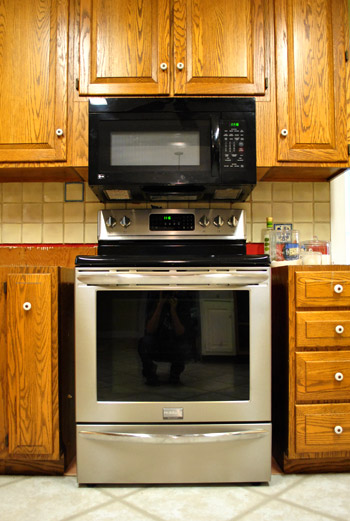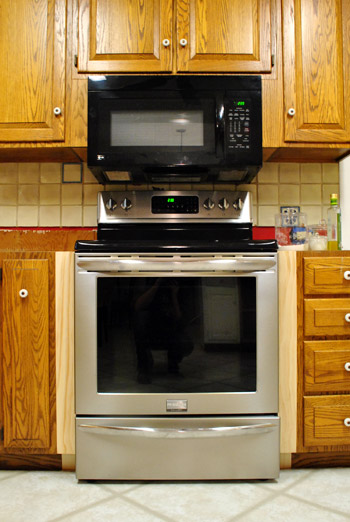You’re cooking up a storm in the kitchen, and suddenly, you drop a spoon. It disappears into that frustrating gap between your stove and countertop.
Sound familiar? You’re not alone. Many people grapple with this pesky space that loves to swallow utensils, crumbs, and spills. But don’t worry—there’s a solution. Imagine a kitchen without that annoying gap, where cleaning is a breeze and lost items are a thing of the past.
Keep reading to discover simple and effective ways to close that gap for good, making your kitchen more functional and your cooking experience more enjoyable. Your kitchen deserves this transformation, and you do too.
Identifying The Gap Causes
Identify the causes of the gap between the stove and countertop to find effective solutions. Misaligned units or uneven surfaces often create these spaces. Addressing these issues ensures a snug fit and enhanced kitchen aesthetics.
Finding a gap between your stove and countertop can be frustrating. You might worry about crumbs slipping through or just want a cleaner look. Understanding what causes these gaps is the first step in fixing them. By knowing the root of the problem, you can choose a practical solution that fits your kitchen’s needs. Let’s dive into some common causes and see how they affect your space.Uneven Flooring
Do you notice your floor slightly sloping? This can cause your stove to sit unevenly, creating a gap. Sometimes, even a small tilt can make the difference between a snug fit and a noticeable space. Consider using a level to check your flooring and determine if this might be the culprit.Countertop Installation
Was your countertop installed in a hurry? Quick installations can lead to misalignments. If the countertop isn’t perfectly aligned, you might find gaps appearing around the stove area. Check the installation records or ask the installer to assess if adjustments are needed.Stove Design
Your stove’s design might not match the countertop’s style or dimensions. Some stoves have unique shapes that don’t align well with standard countertops. Review the stove’s specifications to see if it’s compatible with your counter space.Wear And Tear
Over time, kitchens experience wear and tear. Materials can shift or degrade, leading to gaps between the stove and countertop. Inspect for signs of aging and consider if this might be affecting your kitchen setup.Incorrect Measurements
Were precise measurements used during kitchen planning? Incorrect measurements are a common issue, leading to gaps and misfits. Double-check the dimensions to ensure everything was planned correctly. — Have you identified the cause behind your gap? Recognizing it is half the battle. What steps will you take to ensure a seamless look in your kitchen?Measuring The Gap Size
Identify the gap size between your stove and countertop using a measuring tape. Accurate measurements ensure a perfect fit for fillers. This simple step helps prevent spills and keeps your kitchen looking tidy.
Have you ever noticed that pesky gap between your stove and countertop? It’s more than just an eyesore; it can be a haven for crumbs and spills. Before you jump into fixing it, understanding how to measure the gap size accurately is crucial. This ensures you choose the right solution and materials to bridge that space effectively.Understanding The Tools You Need
Accurate measurement is key, and having the right tools makes it easy. A simple tape measure or ruler can do the trick. If you’re into gadgets, a digital caliper offers precision. Remember, even a tiny error can affect the fit of your solution.Taking The Measurement
First, clear any debris from the gap to ensure a precise measurement. Place the tape measure or ruler flat against the countertop, extending it to the edge of the stove. Note the width of the gap in inches or centimeters. It’s surprising how a small gap can seem much bigger when measured.Recording And Comparing Measurements
Once you’ve measured, jot down the dimensions. It’s smart to measure at multiple points along the gap, as countertops and stoves may not be perfectly aligned. Are the measurements consistent, or is there a variation? This insight helps in selecting a filling material that accommodates any inconsistencies.Considering The Gap’s Impact
Reflect on what the gap means for your kitchen. Are crumbs constantly falling into it, or is it just a visual annoyance? Understanding its impact will guide your choice between purely aesthetic fixes or practical solutions that prevent messes.Evaluating Solutions Based On Size
With measurements in hand, explore options like gap fillers or adjustable strips. Your decision depends on the gap’s size and how much it bothers you. Would a simple silicone strip suffice, or do you need something more robust? Measuring the gap size isn’t just about numbers; it’s about finding a solution that suits your kitchen’s unique character. By taking accurate measurements, you’re one step closer to eliminating that pesky gap once and for all.Choosing The Right Materials
Choosing the right materials is crucial to fix the gap between your stove and countertop. The materials you select affect both functionality and aesthetics. Consider durability and appearance before making a decision.
Heat-resistant Options
Stoves generate a lot of heat. Choose materials that can withstand high temperatures. Silicone is a popular choice. It resists heat and is easy to clean. Another option is metal strips. They offer durability and heat resistance. Ensure the material does not melt or warp over time.
Color And Aesthetic Considerations
The material should blend with your kitchen. Consider the color scheme of your kitchen. Black or stainless steel can match most appliances. Clear silicone can be an unobtrusive choice. It lets the natural beauty of your kitchen shine through. Choose a finish that complements your countertops and stove.

Credit: www.younghouselove.com
Using Gap Fillers
A gap between the stove and countertop can be bothersome. It collects crumbs and spills. Fixing this gap is easy with the right tools. Gap fillers are a practical solution. They ensure a seamless kitchen surface. Below, explore different gap filler options. Each method offers unique benefits.
Silicone Sealants
Silicone sealants are flexible and durable. They form a strong bond between surfaces. Easy to apply, they prevent food and liquids from falling. They are heat-resistant and come in many colors. Choose a sealant that matches your countertop. This keeps your kitchen looking tidy.
Metal Strips
Metal strips provide a sleek finish. They fit snugly into the gap. These strips are easy to clean and maintain. Made from stainless steel, they resist rust. Metal strips come in different sizes and designs. Select one that complements your kitchen decor.
Filler Rods
Filler rods are another effective option. They are usually made from rubber or silicone. These rods fill the gap without any adhesive. They are flexible and can be easily removed. Filler rods come in various widths. Measure your gap to ensure a perfect fit.
Installing Gap Covers
Dealing with the gap between your stove and countertop can be more than just an aesthetic issue. It can become a haven for crumbs and spills. But don’t worry, installing gap covers is a straightforward solution. These covers can eliminate the hassle and keep your kitchen tidy and safe. Let’s explore some options to bridge that gap effectively.
Adjustable Covers
Adjustable gap covers are a versatile choice. They’re designed to fit most gaps without needing precise measurements. You can easily cut them to size, which makes them incredibly user-friendly. Plus, they often come in heat-resistant materials, ensuring that they’ll withstand the temperature near your stove.
Imagine cooking your favorite dish and not worrying about spills sneaking into the gap. These covers can be easily cleaned, saving you time and effort. They’re available in various colors, so you can match them with your kitchen’s style. Does your kitchen have unique dimensions? Adjustable covers can be your go-to solution.
Custom Fit Solutions
Custom fit solutions offer a perfect match for your kitchen’s needs. If you’ve struggled with generic covers not fitting well, custom options might be your answer. They’re tailored to fit the specific gap between your stove and countertop.
Ordering a custom fit might seem daunting, but it’s simpler than you think. You’ll need to measure the gap accurately, but once done, you’ll receive a cover that fits seamlessly. Many companies offer this service online, making it accessible for everyone. Have you ever wished for a cover that blends effortlessly with your kitchen decor? Custom fit solutions provide just that.
So, which option will you choose to tackle the gap in your kitchen? Whether you opt for adjustable or custom fit covers, you’re taking a step toward a cleaner and more organized cooking space.
Diy Fixes
Easily fix the gap between your stove and countertop with foam tubing or silicone. These materials prevent crumbs and spills from falling through. Plus, they offer a neat, seamless look to your kitchen space.
Finding a gap between your stove and countertop can be frustrating, especially when crumbs and spills fall into the abyss. But you don’t need a professional to fix this common issue. With some creativity and elbow grease, you can tackle the gap yourself. Let’s explore some simple hacks and budget-friendly alternatives that can make your kitchen more functional and tidy.Simple Hacks
You might be surprised by how household items can come to your rescue. Try using a foam pipe insulation tube. Cut it to size and press it snugly into the gap. It’s flexible, easy to handle, and does the job well. If you prefer a cleaner look, consider using clear acrylic caulk. It’s quick to apply and dries transparent, blending seamlessly with your kitchen decor. Bonus: it’s waterproof, preventing any liquid from seeping through. Think about using a simple T-shaped silicone gap cover. These are specifically designed for this purpose and slide easily into place. They’re heat-resistant and easy to clean, making them a practical choice for busy kitchens.Budget-friendly Alternatives
You don’t have to break the bank to fix this gap. Look around your home for items that can be repurposed. An old pool noodle, cut to fit, can serve as a makeshift gap filler. It’s a quirky solution, but surprisingly effective. Visit your local hardware store and check out weatherstripping options. They’re affordable and come in various sizes and shapes, allowing you to customize the fit. Feeling crafty? Use some leftover wood strips to bridge the gap. Sand them down, paint them to match your kitchen, and slide them in. Not only do they fill the gap, but they add a personalized touch to your space. Taking a DIY approach to fixing the gap between your stove and countertop can be rewarding. What creative solution will you try first?Preventive Measures
Preventing gaps between your stove and countertop can save you from future headaches. Small gaps can collect food particles and debris. This can lead to hygiene issues. Taking preventive measures can help maintain a clean kitchen space. Regular maintenance and proper installation are key. These steps ensure a seamless and functional kitchen environment.
Regular Maintenance
Check the alignment of your stove and countertop often. Ensure they are level and close together. Dust and clean the area regularly. Use a vacuum to remove crumbs and dirt. This prevents buildup that can widen gaps over time. A clean kitchen is a healthy kitchen.
Proper Installation Techniques
A correct installation is vital. Make sure the stove fits snugly with the countertop. Measure the space carefully before buying a stove. Use a filler strip if needed. This keeps the gap minimal. Choose professional installation for the best results. Skilled installers ensure everything fits perfectly.

Credit: www.younghouselove.com

Credit: www.amazon.com
Frequently Asked Questions
How Do I Measure The Gap Accurately?
Use a measuring tape. Record the width and depth of the gap. Ensure precision for best results.
What Materials Can Fill The Gap?
Choose silicone, rubber strips, or metal trim. These materials are heat-resistant and durable. Great options for a neat look.
Can I Use Diy Methods To Fix The Gap?
Yes, you can. DIY solutions like foam sealants or caulk are effective. Easy and affordable.
How Often Should I Check The Gap?
Inspect the gap monthly. Regular checks prevent dirt build-up. Maintain cleanliness and safety.
Are Professional Services Necessary For Large Gaps?
Consider professionals for large gaps. They provide expert solutions. Ensure proper installation and longevity.
Conclusion
Fixing the gap between your stove and countertop is simple. Start with measuring the gap accurately. Then, choose the right materials. Foam strips or silicone can work well. Clean the area thoroughly before applying. This prevents dirt from getting trapped.
Press the filler firmly into place. Check for any loose edges. Regularly inspect the seal for wear. Replace if necessary. Keeping the gap closed enhances kitchen hygiene. It also improves the kitchen’s appearance. Follow these steps for a neat finish.
Enjoy a tidier kitchen environment.





